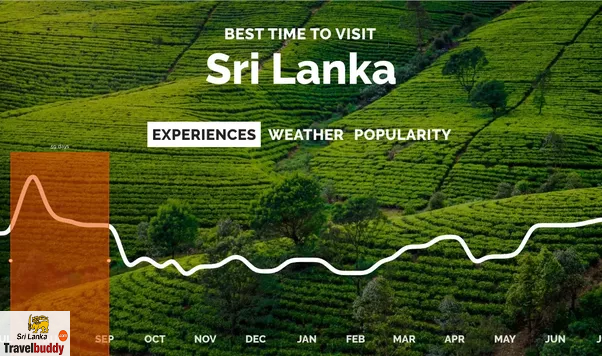Table of Contents
I’m going to be completely honest with you all. There is not one best time of the year to travel to Sri Lanka. Why? Well, Sri Lanka’s climate is more complex than many other countries. There is not a specific interval for hot weather and another for rainy weather. Unfortunately, rain is highly unpredictable almost all over the island. Since Sri Lanka is an island near the Equator (the hottest region on Earth), the temperatures remain fairly consistent throughout the year. But of course, temperatures also depend on where you live. If you go to the beach, you’ll enjoy it. If you go to the inner lowland areas, it’ll get hot and uncomfortable, while the highlands and hilly areas will be chilly and might even freeze at night times.
Nonetheless, I’ll try to educate you about what are generally considered the most appropriate times to visit different parts of Sri Lanka. But be warned, Sri Lanka always has imminent showers. Sometimes though, you might not experience any rain at all.
Sri Lanka Weather by Month
First of all, you’ll have to bear with us the ‘technical’ details of Sri Lanka’s climatic pattern. After reading through this first section, you’ll better understand Sri Lanka’s when and where. We’ll try to keep complicated jargon to a minimum.
a) Yala Monsoon (April to September – Mid Year)
Also known as the West and South Monsoon, the Yala Monsoon is the gentler of the two major monsoons. It occurs from April to September. During this season, heavy rainfall can be expected on the southern and western coasts. That means that the popular beaches of the West are a no-no (unless you enjoy torrential rains and beach water). If you’ve read our blog on Sri Lanka’s beaches, you may remember that the south-western beaches include Bentota, Galle and Mirissa, among others.
b) Maha Monsoon (Dec to March – Year end & start)
The harshest of the two monsoons is the North and East Monsoon, the Maha Monsoon. It mostly affects, as the name implies, northern and eastern areas. Rains are heavy and the hilly areas can get very chilly. You probably shouldn’t go to the eastern coast during this season and stick to the inner and western parts of Sri Lanka. This is if you visit at this time of year.
c) The Inter-Monsoon
Lastly, you should know that there is also a less predictable and less defined rainfall period known as the Inter-Monsoon period. You can guess from the name that it occurs between October and November. Different parts of the countries have pleasant, sporadic rains during this period. However, note the emphasis on the word ‘unpredictable’ here; in some years and in some parts, the Inter-Monsoon doesn’t witness any rainfalls, while at other times, the rains may become….. disappointingly pleasant.
Temperature and Humidity
As for temperature changes, there is little to say. As mentioned already, due to Sri Lanka’s proximity to the Equatorial Region (the hottest region on Earth), temperatures rarely go to extremes. They remain around 25-30oC. Of course, temperatures rise higher during the afternoon and in central areas, while they go down during the night and in hilly areas.
As for humidity, you have few options there. Being an island surrounded by the sea, Sri Lanka is a humid country, with generally 70-90% humidity throughout the year. So it wouldn’t be much use finding a time of year when the humidity index is low.
Beach Season
Now that you know the climatic patterns of Sri Lanka, we hope you’ll better understand the most suitable seasons for different beaches in Sri Lanka. It is pretty clear though. If you wish to visit the popular northern and eastern beaches, like Arugam Bay, Passikuda or Marble Beach, you should avoid visiting in December to March, but you can take advantage of pretty much any other time of the year, except the October-November inter-monsoon season. On the other hand, visiting the western and southern beaches like those in Colombo (Crow Island, Mount Lavina), Bentota or Galle et cetera, should preferably be done in November to March. However, since the Yala Monsoon is less harsh, you could move around even in the mid-year months of April to September as well.
The Annual Esala Pareherea
Okay, having mentioned the times of the year in terms of months, we must mention another time of the year when it is awesome to be in Sri Lanka. Specifically, in the well-known Sri Lankan city of Kandy. Kandy is home to the world-famous Temple of the Tooth (locally known as Sri Dalada Maligawa). If you’ve read our blog on “Things to do in Kandy”, you’ll remember the Annual Festival of the Tooth, or Esala Parehera. This is held from July to August. The tooth in question is a relic of the ancient Lord Buddha, founder of the Buddhist creed. Since Sri Lanka’s major religion is Buddhism, the annual festival marks a significant festival for the Buddhist community in Sri Lanka and other countries. It’s pretty much like Christmas for Christians and Eid-ul-Fitr or Eid-ul-Azha for Muslims. You can find more details about the fun and activities involved with Esala Pareherea in our blog dedicated to Kandy.
Christmas and New Year
In order to sign off for the day, we must mention the holiday season in Sri Lanka. This is also a very expensive time of year, with lots of shopping and partying. You might even find substantial discounts and sales at the markets. Of course, since it’ll be December or January, you’ll avoid the Northern and Eastern coasts because of, you guessed it, the Maha Monsoon.
We hope you enjoyed reading our blog about Sri Lanka and gained something from it. Don’t forget to leave your thoughts and suggestions in the comments.




